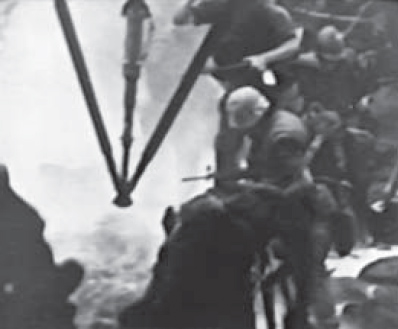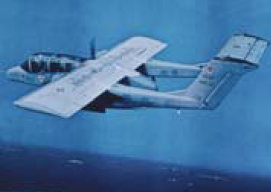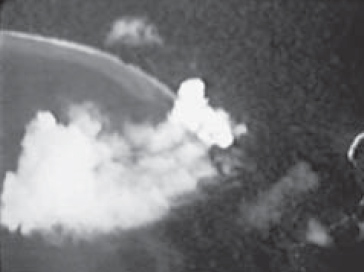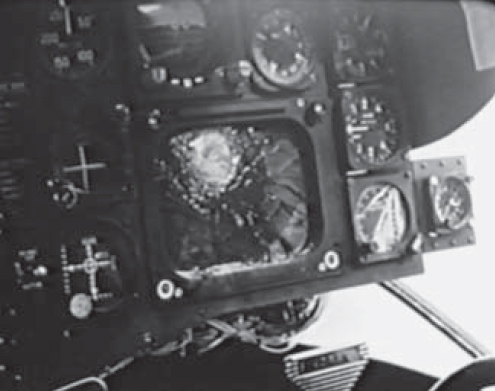
The Mayaguez incident had profound military implications. Ford and the NSC avoided another USS Pueblo incident, with its lengthy negotiations, and America certainly acted to defend its interests. Yet although successful in meeting the national objective of quickly securing the safe return of ship and crew, the mission provided sobering lessons that affect military activities today.
Many aspects of the operation provided an early demonstration of modern communications advances. Despite the global distances, local commanders were now under the constant watch of their chain of command, from the President to their immediate headquarters. Commanders could now listen in, comment on, and override decisions by their field subordinates. The President could literally micro-manage a tactical situation instead of focusing on a strategic or long-term view. A local commander’s initiative and ability to make decisions was therefore at risk of disappearing. Potentially, an organization in combat might suffer a loss of unity of command, as decisions from outside the immediate unit create confusion in direction, especially if leaders make those decisions with incomplete information or a lack of situational awareness. In addition, local commanders might have to wait for a decision, the loss of tempo destroying initiative and innovation. Communications and information technology improved dramatically after 1975. One might argue that the ability of high-level commanders to affect tactical operations reached a critical juncture five years later during Operation Eagle Claw, which ended in a humiliating failure for forces trying to rescue American embassy hostages in Iran.

In the photograph taken from JG11, the survivors from K23 scramble onboard the HH-53C. After several attempts to extricate Cicere’s marines, the Air Force finally got the men off the East Beach. Fears of the marines’ position being overrun by the Khmer Rouge made their rescue a priority over other rescues. (US Air Force)
Presidential decision-making was also crucial to the incident. Ford had inherited the remains of the Vietnam conflict with Operation Eagle Pull and Frequent Wind. Finding some way to salvage America’s honor by demonstrating that it was not a “paper tiger” would go a long way to sooth the pain of Vietnam. Some of NSC staff also wanted to avoid another USS Pueblo incident, which forced the nation into a bitter negotiation with the North Koreans. Under crisis, Ford and the NSC had to make decisions from 11 time zones away, and in some cases without benefit of current information. The ability to issue directives instantly to the field compounded this problem.
In some situations, rapid communications to direct subordinates is a definite advantage, assuming higher headquarters have all the available information. In the case of the Mayaguez, Ford’s decision to cease all military operations and disengage with the Cambodians almost created a situation in which the extraction of the marines might have been bloodier. The choice to sink all boats in the Koh Tang area could also have resulted in the death of Miller and his crew on the Thai fishing boat, if not for the P-3 and the Wilson’s captain identifying Miller before firing. Without proper situational awareness by higher command, policies might be contradictory at best or deadly at worst.
Like many military operations, current and accurate information was lacking. CINCPAC forces did not have maps with the proper scale or accuracy to conduct targeting. More serious was the problem concerning enemy force estimates on Koh Tang. The three sources concerning enemy strength varied widely in their data. Intelligence reporting to the marines and 7AF units also seemed fragmented. Some received DIA/IPAC reports; the marines thought they would face limited opposition. Most military leaders would have planned for the worst, by using the DIA estimate of 150 to 200 Khmer Rouge soldiers. Similarly, if CINCPAC had an accurate location for the Mayaguez crew, then the Koh Tang assault might not have happened. CINCPAC did make corrections to intelligence dissemination and feedback based on its experience of the operation.
The various military forces used in the operation worked well together given the circumstances. Still, a lack of joint training affected their ability to operate together. Coordinating close air support between Air Force and USMC air units was difficult given their different communications systems. The capacity for Air Force helicopters to conduct a beach assault was also a challenge. Three downed and many damaged helicopters seriously impaired commanders’ options for conducting a second-wave attack and extraction. However, the disparate forces were able to adapt and adjust to the difficult situation. Commanders also demonstrated flexibility in creating plans and conducting operations with the limited resources deployed in Southeast Asia. Washington pulled together and massed forces within hours of the Mayaguez’s capture. CINCPAC planners had to coordinate operations over wide geographic distances, and at great speed. Such missions, and problems encountered in Vietnam, Iran, and Grenada, led to more emphasis on inter-service cooperation, planning, training, and equipment. The Goldwater–Nichols Act of 1986 tried to address many of the issues about operating in a joint service environment and made significant progress in improving military capability.

OV-10As, like this aircraft, from the 23rd Tactical Air Support Squadron took over forward air control duties from the 3rd Tactical Fighter Squadron A-7Ds. The OV-10As gave the marines and the aircrew crews a different perspective to control and direct operations against the Khmer Rouge. They worked in pairs: one briefed incoming aircraft, the other directed air strikes and kept watch over the area. (US Air Force)
Diplomatic moves at the time were particularly difficult to make given the recent Cambodian revolution. Washington attempted, through several avenues, to send messages to Phnom Penh to release the Mayaguez. Trying to establish who decided to seize and keep the crew has never been determined. State Department officials did not know whom to contact. They tried to get the Chinese government to intercede, initially unsuccessfully, but word eventually arrived from Tehran that a PRC diplomat indicated a release was possible. Time urgency and other motivations may have scuttled the White House’s attempts to secure the release of the crew without having to initiate the Koh Tang operations. Diplomatic efforts take time, Ford and the NSC wanted to resolve the issue immediately.
During the Mayaguez incident, objectives and priorities seemed to be in conflict in some instances. The overall safety of the Mayaguez crew was potentially jeopardized by several actions, such as the sinking of patrol boats that might have held the captives, conducting air strikes near Kompong Som and Ream, and landing on Koh Tang without knowledge of the prisoners’ location. Although CINCPAC and JCS planners designed the air raids on the Kompong Som area to avoid Cambodian reinforcements deploying to Koh Tang, the attacks they could have also worked against Washington. The original plan to use B-52s could have inflicted massive civilian casualties, turning world and domestic sympathy into condemnation. National leaders debated the use of the air raids: a demonstrative action or tactical support for the Koh Tang assault? Expanded American military actions throughout the region might have hardened Phnom Penh’s stance on releasing the crew. Still, American air operations, including sinking Cambodian patrol boats, caught Phnom Penh’s attention and played a significant part in the release of the Mayaguez’s crew.
A significant issue raised by the crisis was the question of when to use military force. Ford and the NSC first attempted diplomatic means of resolution, but unfortunately time demands and the desire to demonstrate America’s military muscle may have short-circuited diplomacy. Trying to contact the Cambodian government directly was difficult, if not impossible. Without the ability to transmit American demands, Washington had to use third parties or the world press. This situation contributed to uncertainty about possible settlement of the crisis. Today, governments have similar problems contacting insurgents or other non-state actors, decreasing the likelihood of negotiated settlements and increasing the possibility of armed conflict.
Domestic political concerns also clouded the NSC’s decision-making processes by creating an artificial time constraint. The War Powers Resolution and the Cooper–Church Amendment forced Ford to get the mission planned and completed before any serious congressional opposition developed. If the operation dragged on and incurred heavy casualties, the American public and Congress might have demanded a halt. CINCPAC had to plan and execute based on assumptions that Ford could convince Congress that the operation was necessary.

Khmer Rouge defenders fought to stop all the Air Force rescue efforts. An A-7D aircraft dropped riot control agent cluster bombs on the East Beach in an attempt to suppress the Cambodians, but the wind blew the gas offshore into the helicopters instead. (US Air Force)
Some critics of the Mayaguez operation would argue that the loss of 41 American military personnel was too high to rescue the 40-member container ship crew. A simple cost analysis appears too simplistic. Indeed, larger national interests and objectives were at play above and beyond the release of crew and ship. The USMC, USAF, and US Navy personnel involved in the military operations in the Gulf of Thailand largely achieved all American mission objectives, but the toll was heavy.
The United States’ image and credibility had suffered amongst her NATO allies and Cold War foes after Vietnam. The Mayaguez incident was a test of Washington’s will and capability to use military force. The United States demonstrated that it would protect American interests globally. North Korea, the Soviet Union, China, and others watched as the nation reacted quickly and adapted to a dynamic situation. American military actions appeared to salvage the nation’s honor and reputation abroad, but also domestically. By 1975, the United States had endured the loss of Vietnam, impeachment efforts and the resignation of a President, rising unemployment, and other problems. Despite the rescue of the Mayaguez and its crew, critics argued that the operation had several deadly flaws. Difficultes with joint planning, command and control, incompatibility of equipment, the War Powers Resolution, and operational mistakes resulted in congressional investigations and internal reviews within the Pentagon. Many of these difficulties, along with problems during the failed Iranian hostage rescue and Grenada operations, resulted in a movement to reform how Washington would conduct future joint operations, training, and acquisition of common equipment that would result in the Goldwater–Nichols Act of 1986, a major milestone in changing the face of the American military.
The national and military leaders involved in the Mayaguez incident went on to take very different paths. Gerald Ford survived the incident with a boost in his domestic popularity. He later reorganized his cabinet in a major shakeup in November 1975, known as the “Halloween Massacre.” The cabinet became more conservative, and Ford replaced Kissinger for Scowcroft as his national security advisor. Still smarting from perceived problems in military planning, capability, and operations, Ford fired Schlesinger and replaced him with Donald Rumsfeld, the youngest Secretary of Defense. Rumsfeld’s deputy, Richard Cheney, became Ford’s White House Chief of Staff. George H. W. Bush became DCI when Ford forced Colby out. Bush would become the 41st President and Cheney served him as his Secretary of Defense. Coincidentally, Bush’s son, George W. Bush, would become the 43rd President. He selected Cheney as his Vice President and Rumsfeld as Secretary of Defense. Several of these selections would have a significant impact on future American foreign policy. Unfortunately, Gerald Ford’s later tenure suffered from declining presidential power, a very weak economy, and public resentment of his pardon of Richard Nixon. Although surviving two assassination attempts, Ford was not re-elected President. He died on December 26, 2006.

This photograph illustrates damage to JG13 after its failed attempt to land on the East Beach. A round entered the pilot’s instrument panel via the lower windshield. JG13 was still able to fly, but was out of commission after the operation. (US Air Force)
Henry Kissinger remained Secretary of State in the Ford administration. He retained great influence in foreign policy after he left office. As a scholar and consultant, Kissinger advised George W. Bush on a range of foreign policy issues, especially on Israel and the Middle East.
David C. Jones, then acting Chairman of the JCS, completed his tour as Air Force Chief of Staff. Jones rose to Chairman of the JCS in 1978. Jones had heavily criticized the planning and conduct of the Mayaguez incident. His solution was more intensively centralized command, control, and planning of similar military operations. Jones remained in office until 1982, when he retired. During his tenure, he oversaw the failed attempt to rescue American military and embassy personnel in Iran through Operation Eagle Claw, an action that suffered from constant micro-management from senior leadership.